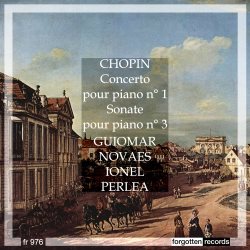|

|
Frédéric CHOPIN (1810-1849)
Piano Concerto No. 1 in E minor, Op. 11 [43:38]
Piano Sonata No. 3 in B minor, Op. 58 [24:16]
Guiomar Novaes (piano)
Orchestre Symphonique de Bamberg/Ionel Perlea
rec. 18 May 1957, Bamberg (Op.11); 14 March 1952, Columbia 30th Street Studio, New York (Op.58)
FORGOTTEN RECORDS FR976 [67:55]
South America produced two giants of the keyboard in the years spanning the end of the 19th and the beginning of the 20th centuries. Claudio Arrau was born in Chile in 1903 and firmly established a reputation for himself as one of the great pianists of his age. The other, Guiomar Novaes, was a native of Brazil, and was born eight years earlier, in 1895. She had lessons as a child with Luigi Chiaffarelli, a pupil of Busoni, and later with Isidore Philipp at the Paris Conservatoire, where she graduated with first prize in 1911. Embarking on a concert career, she travelled Europe, but this was curtailed by the outbreak of World War I. She then returned to her native country. For fifty-seven years she made annual trips to the States. Novaes made a name for herself as a fine Chopin player, bringing to his music poetry, seamless legato, spontaneity and freedom of expression.
This intuitive feeling for Chopin’s music is all too evident in this recording from 1957 of the First Piano Concerto. Poetry, expressive lyricism, exquisite shaping of phrases, it’s all here, underpinned by a formidable technique and musical intelligence. The slow movement has a graceful simplicity and haunting beauty - the effect is spellbinding. Novaes achieves an effective dynamic spectrum and myriad tone colours with judicious pedalling. Instinctive phrasing and projection of melodic lines result in captivating and compelling results. Perlea proves himself a sympathetic partner. Balance between orchestra and soloist is ideal.
The Piano Sonata no. 3 in B minor opens with a true maestoso grandeur. Novaes addresses the dramatic moments with great flair and brilliance. The poignant melody of the second subject, however, has some rather over-indulgent rubato, with the pianist slightly over-gilding the lily. The Scherzo is fleet of foot with a good contrasting middle section. The Largo’s declamatory opening ushers in this nocturne-like slow movement, with serenity pervading the reading. The finale is a technical tour de force, scintillating pearl-like right hand runs adding to the excitement.
The two works featured here have seen the light of day previously on a now deleted Urania 2 CD set. I have never heard those transfers and consequently am unable to offer any comparisons. The transfers here have been carried out to the usual high standard that can be expected from Forgotten Records, using first class LP source material. In the absence of any documentation, references to relevant websites are provided for the enthusiastic devotee.
Stephen Greenbank
 |
 |
|
